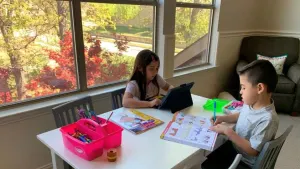More Stories
As parents and students start getting ready to return to school, many will also have to make plans for the possibility of home schooling or remote learning.
Here are six tips for students and parents when home schooling and remote learning:
1. Stay in touch with your child’s school
Many schools are offering lessons online (virtual learning). Review assignments from the school, and help your child establish a reasonable pace for completing the work. You may need to assist your child with turning on devices, reading instructions, and typing answers.
Many schools are offering lessons online (virtual learning). Review assignments from the school, and help your child establish a reasonable pace for completing the work. You may need to assist your child with turning on devices, reading instructions, and typing answers.
Communicate challenges to your school. If you face technology or connectivity issues, or if your child is having a hard time completing assignments, let the school know.
2. Create a flexible schedule and routine for learning at home
Have consistent bedtimes and get up at the same time, Monday through Friday.
Have consistent bedtimes and get up at the same time, Monday through Friday.
Structure the day for learning, free time, healthy meals and snacks, and physical activity.
Allow flexibility in the schedule — it’s OK to adapt based on your day.
3. Consider the needs and adjustment required for your child's age group
The transition to being at home will be different for preschoolers, K-5, middle school students, and high school students. Talk to your child about expectations and how they are adjusting to being at home versus at school.
The transition to being at home will be different for preschoolers, K-5, middle school students, and high school students. Talk to your child about expectations and how they are adjusting to being at home versus at school.
Consider ways your child can stay connected with their friends without spending time in person.
4. Look for ways to make learning fun
Have hands-on activities, like puzzles, painting, drawing, and making things.
Have hands-on activities, like puzzles, painting, drawing, and making things.
Independent play can also be used in place of structured learning. Encourage children to build a fort from sheets or practice counting by stacking blocks.
Practice handwriting and grammar by writing letters to family members. This is a great way to connect and limit face-to-face contact.
Start a journal with your child to document this time and discuss the shared experience.
Use audiobooks or see if your local library is hosting virtual or live-streamed reading events.
5. Ask about school meal services
Check with your school on plans to continue meal services during the school dismissal. Many schools are keeping school facilities open to allow families to pick up meals or are providing grab-and-go meals at a central location.
Check with your school on plans to continue meal services during the school dismissal. Many schools are keeping school facilities open to allow families to pick up meals or are providing grab-and-go meals at a central location.
6. Look for free online learning resources
There are many free, online resources to learn something new from the comfort of your own home.
There are many free, online resources to learn something new from the comfort of your own home.
Click here for more tips from the Centers for Disease Control and Prevention.
More from News 12
0:26

At-home COVID-19 test kits to be distributed at 2 Nassau locations this weekend
0:23

New Excelsior Pass Plus app extends beyond New York jurisdiction

Your Coronavirus 2020 Photos

10 online learning tools for students to use at home

7 online remote learning tools for educators
8:38:20
